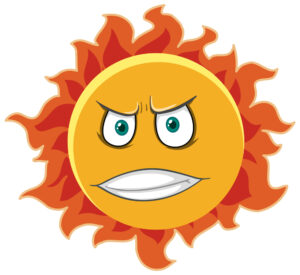Wow, has this summer ever been hot, hot, hot! I hope you’re staying cool.
The opposite of hypothermia, if you’re writing about heatstroke, excessive heat can cause your characters a variety of problems. Our bodies release heat mainly by sweating (perspiring for the romance writers). When sweat can’t evaporate to cool your character’s skin, core body temperature will rise fast.
At some point, sweating stops. In only ten to fifteen minutes, body temperature can rise to a lethal level.
DEFINITIONS:
1. Heatstroke: most severe, occurs in high heat/humidity levels and depends on the heat index
2. Heat exhaustion or heat cramps: mild to moderate, due to loss of salt in the body from too much sweating
3. Heat rash: (AKA prickly heat rash) mild, irritating or itchy rash
Questions for authors writing about heatstroke:
> What is your character wearing? Lightweight clothing or body armor
> Has your character suffered a recent gastrointestinal illness or fever, or is already dehydrated? (like norovirus in Hawaii, not recommended by this author)
> Does your character have other chronic illnesses, and do they take medications?
> Age? Under age 4 or over 65 are more susceptible to heat issues
> Substance use or abuse – alcohol in particular increases the risk, as do amphetamines and cocaine
> Pregnant character? More prone to heat issues
> Overweight? Obesity can contribute to a higher risk
> Exercising hard or otherwise exerting/working? (or my preferred method –lazily drinking sweet tea on a shaded porch under a fan)
> Are they acclimated? Moving quickly from a cold climate to the desert without acclimation will increase the risk and vice versa. (Why camels don’t do well in Alaska)
Unlike hypothermia, which progresses along a path from shivers to severe frostbite, given the right circumstances, a person can suffer a heat stroke without prior symptoms or warning.
Given the right circumstances, a person can suffer a heat stroke without prior symptoms or warning. Learn why at Novel Malpractice! Share on X

Sun cartoon character with angry face expression on white background illustration
“SOME LIKE IT HOT!”
Prickly heat won’t harm your character; it’s just itchy, annoying small red bumps in skin folds or any skin area where strong sun can strike dark clothing. (like a black one-piece swimsuit at Disneyworld in August. MISTAKE!)
Heat cramps result from heavy exercise or work in hot environments, inside or out, when your character becomes dehydrated from losing too much salt through their sweat. Muscles that cramp tend to be the ones used for a particular activity or work.
Heat exhaustion includes:
- heat cramps
- heavy sweating
- fatigue
- headache
- nausea
- dizziness
- dizziness upon standing (blood pressure drops all of a sudden due to low fluid in the body,
- weak and rapid pulse
- faintness (not loss of consciousness)
- cool moist skin that can still raise goose bumps
Some symptoms of heat exhaustion overlap with heat stroke. Learn more at Novel Malpractice. Get your medical details right! Share on X
Heatstroke is a life-threatening, 911 scenario. The medical definition is core body temperature above 104 degrees along with changes in mental status (central nervous system issues) such as:
> disorientation
> fast pulse
> flushing
> rapid shallow breathing
> throbbing headache
> hot, red dry skin (no sweating)
> slurred speech,
> confusion,
> agitation,
> hallucinations,
> muscle twitching,
> loss of consciousness,
> coma
>seizures.
Heatstroke is not the same as a standard stroke, where a brain hemorrhage or clot can affect one side of the body.
It can be difficult to distinguish between heat exhaustion and heat stroke, but once neurological (brain) issues appear, you have landed your character in an emergency situation. Without treatment or removal from a hot environment, heat stroke may result in death.

(PS: Don’t confuse heat illness with a different disorder called “hyperthermia” – a malfunctioning internal thermostat in the brain that sends body temperature too high.)
DEEPER DIVES for WRITING ABOUT HEATSTROKE:
https://my.clevelandclinic.org/health/diseases/21812-heatstroke
https://www.mayoclinic.org/diseases-conditions/heat-stroke/symptoms-causes/syc-20353581
https://www.ncbi.nlm.nih.gov/books/NBK537135/
SUPER-Deep dive into heatstroke:


